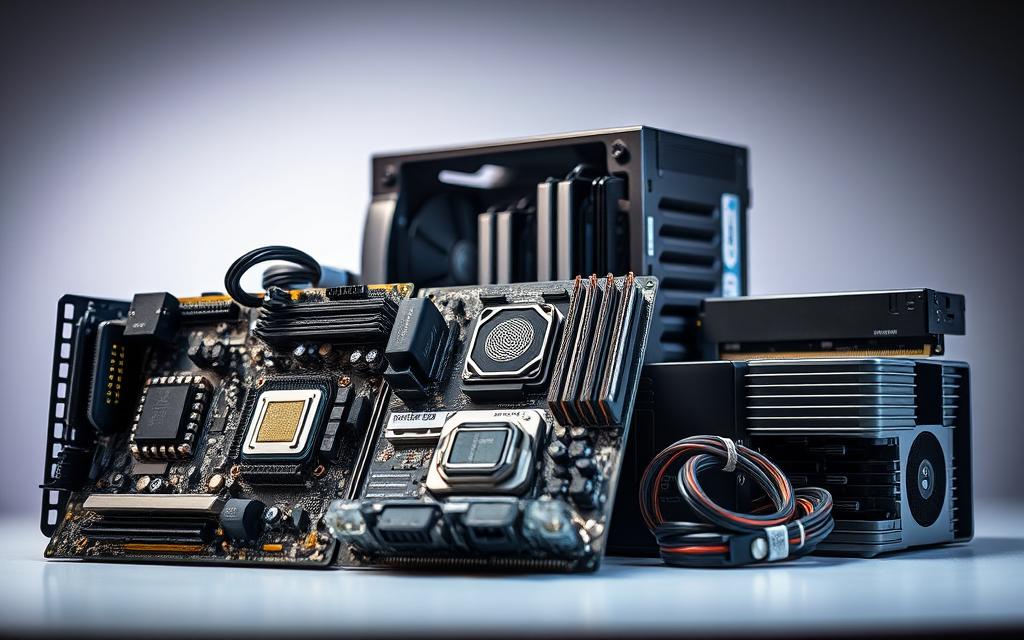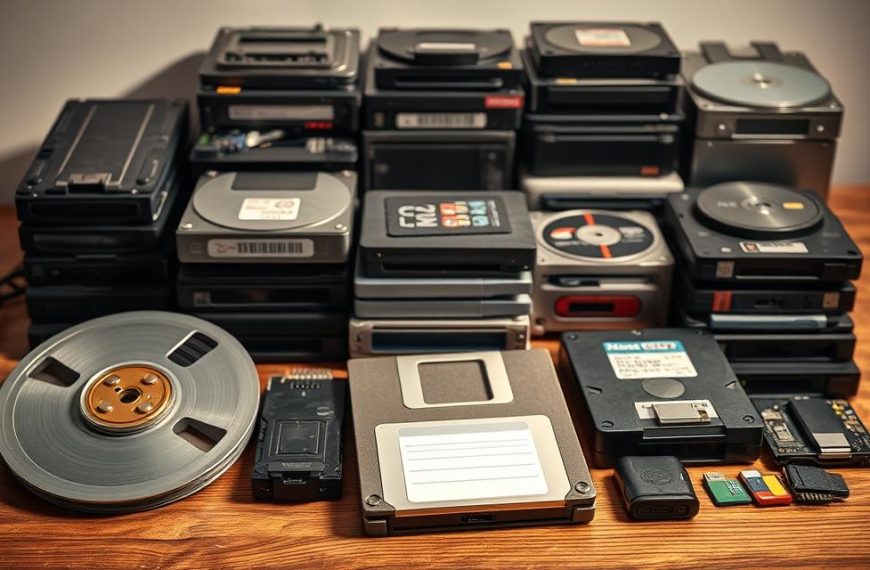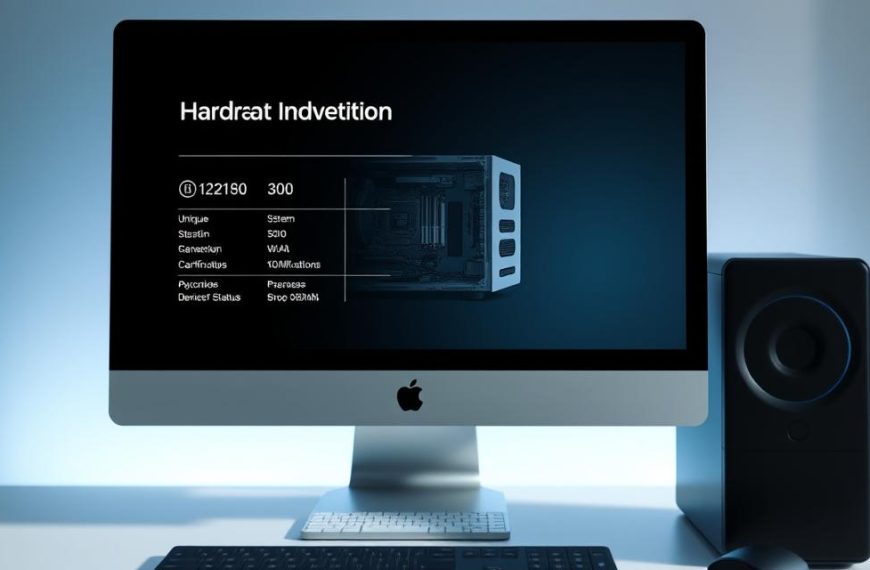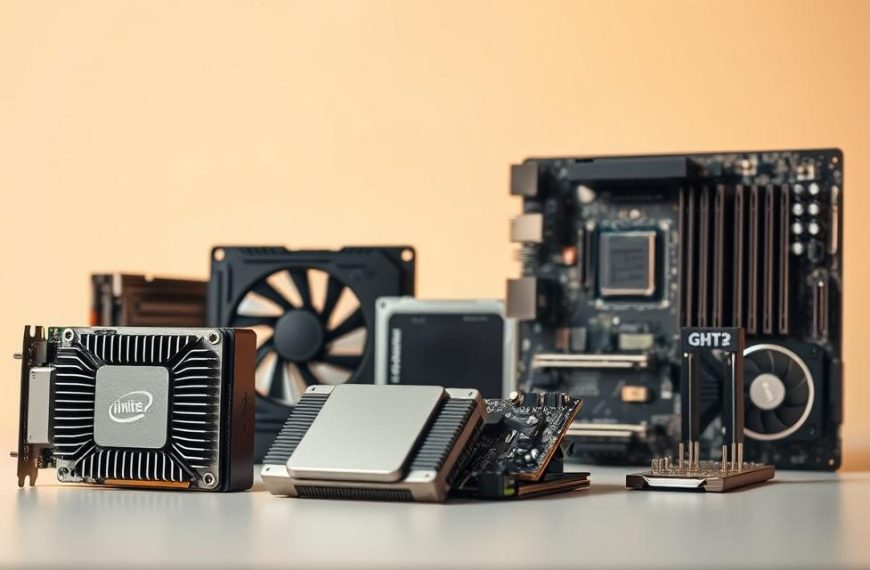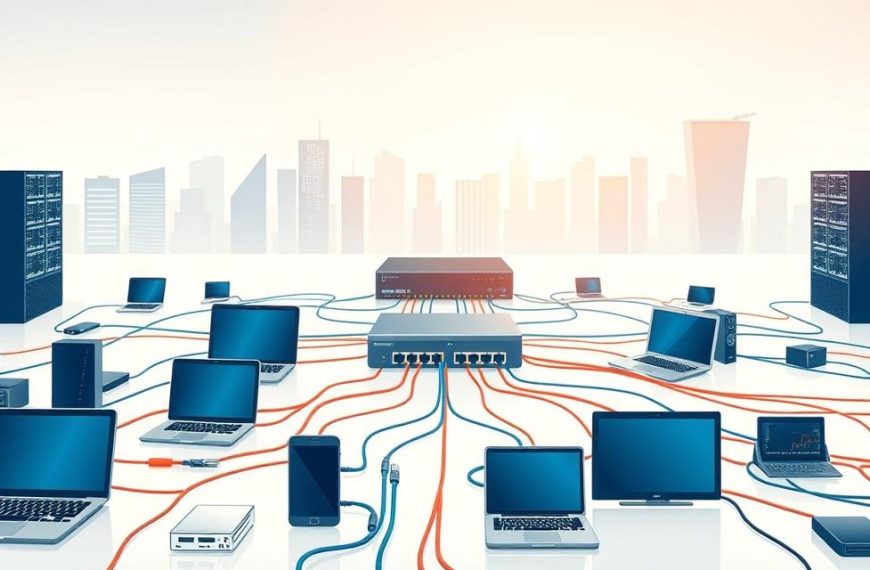Computer hardware forms the physical foundation of digital technology. It’s the backbone of every computing device, enabling complex digital interactions. These critical components work together seamlessly in devices from laptops to workstations.
Computer hardware includes a variety of interconnected elements. Modern systems use sophisticated processors with clock speeds of 1-5 GHz. Advanced hardware technology has seen impressive performance gains. Between 1986 and 2003, annual improvements exceeded 50%.
The inner workings of digital devices reveal intricate architecture. Multi-core processors are now standard, boosting parallel processing abilities. GPUs are often integrated into CPUs to meet growing demands for better performance.
Hardware design keeps evolving with technological advances. The computer hardware landscape shows remarkable diversity and innovation. From tiny embedded systems to powerful supercomputers, each part plays a vital role.
Understanding Computer Hardware Fundamentals
Computer hardware forms the physical core of digital technology. It consists of tangible parts that bring computational abilities to life. These electronic components work together to turn digital instructions into functional experiences.
The Difference Between Hardware and Software
Hardware and software are key to understanding computer architecture. Hardware includes physical parts you can touch, like processors and memory modules. It also includes motherboards and graphics cards.
Software consists of programs and instructions that guide hardware operations. These digital commands allow computers to perform complex tasks efficiently.
Basic Hardware Architecture
Modern computers typically follow the von Neumann model. This design allows data and instructions to flow between connected components. The basic structure includes processing units, memory systems, and input/output interfaces.
The Evolution of Computer Components
Hardware has evolved rapidly over time. We’ve moved from room-sized mechanical computers to tiny integrated circuits. This progress has greatly improved computing power.
Key milestones include vacuum tube computers in the 1940s and transistor-based systems in the 1950s. The 1960s saw integrated circuit development, while the 1970s brought the microprocessor revolution.
Each stage of hardware evolution has boosted computational power. It has also reduced physical size and energy use.
What Are the Main Components of Computer Hardware
Grasping computer hardware basics is vital for tech enthusiasts. Key parts form the core of digital devices. They work together to process data and enable user interaction.
Modern computers have several critical hardware elements. These parts work in harmony to deliver smooth performance. They fall into key groups:
- Processing Units
- Memory Systems
- Storage Devices
- Input/Output Interfaces
- Power Management Systems
Let’s explore the core hardware bits that power computing:
- Motherboard: The central hub connecting all hardware components
- Central Processing Unit (CPU): The computer’s computational brain
- Random Access Memory (RAM): Temporary data storage
- Storage Drives: Long-term data preservation
| Component | Key Specifications | Performance Range |
|---|---|---|
| RAM | Memory Capacity | 4 GB to 64 GB |
| CPU | Clock Speed | 3.0 GHz and above |
| Storage | Drive Type | HDD/SSD (120 GB to 10 TB) |
Each hardware part plays a crucial role in system function. The power supply unit ensures stable electricity delivery. Input devices like keyboards help users interact.
Modern computers use advanced tech to boost performance. These innovations make our digital experience smoother and more efficient.
Essential Processing and Memory Components
Computer hardware relies on complex processing and memory systems to execute tasks. The central processing unit (CPU) acts as the computer’s brain. It manages computational operations with impressive speed and precision.
Modern CPU processing transforms raw data into meaningful computational results. The typical CPU has six critical components:
- Control Unit (CU)
- Arithmetic Logic Unit (ALU)
- Registers
- Cache Memory
- Bus Systems
- Clock Mechanism
How CPUs Process Information
CPU processing occurs through remarkable computational pathways. Today’s processors operate at clock speeds of 3 to 5 gigahertz (GHz). This allows billions of calculations per second.
The ALU performs complex arithmetic and logical operations. It acts as a vital link between primary and secondary storage systems.
Memory Hierarchy and Performance
Computer memory types are crucial for system performance. RAM provides short-term, volatile memory essential for multitasking. Cache memory is a small high-speed RAM within the processor.
It enables faster data retrieval compared to standard memory modules.
Graphics Processing Units and Visual Computing
GPU functions go beyond traditional graphics rendering. These specialised processors are vital in scientific computing and artificial intelligence. They also handle complex visual computations.
Modern GPUs can manage intricate parallel processing tasks with exceptional efficiency.
The interplay between CPU processing, memory hierarchy, and GPU functions forms the basis of modern computing. This combination creates powerful computational capabilities for various applications.
Storage and Power Management Systems
Modern computers need advanced storage devices and power management systems. These ensure top performance and reliability. Computer storage devices are vital for keeping and accessing digital information.
The main types of computer storage devices are:
- Hard Disk Drives (HDDs): Traditional storage with mechanical components
- Solid-State Drives (SSDs): Faster, more reliable flash-based storage
- NVMe Drives: High-speed storage with direct PCIe connectivity
Power supply units are crucial for managing energy in computer systems. They change alternating current to direct current. This ensures stable power for internal components.
Modern power supplies aim to maximise energy efficiency. Units with 80 Plus certification can reach 94% efficiency at 50% load.
Energy efficiency is a top priority for manufacturers and users. New power supply units are designed to:
- Reduce electrical consumption
- Minimise heat generation
- Provide stable voltage regulation
Most power supplies work best at about 50% of their total capacity. Choosing a power supply with twice the needed wattage can improve energy performance.
Efficient power management is not just about saving electricity—it’s about creating more sustainable and reliable computing environments.
Conclusion
Computer hardware evolves rapidly, transforming our digital interactions. From 1986 to 2003, yearly performance improvements topped 50%. This progress led to sophisticated devices like tablets and smartphones.
The future promises exciting developments in quantum computing and neuromorphic chips. These trends will revolutionise computational capabilities. Devices will perform millions of calculations per second with unmatched accuracy.
Hardware maintenance is crucial as systems grow more complex. It ensures optimal performance and longevity of computing equipment. Understanding computer hardware components remains vital in our software-driven world.
The interplay between CPUs, RAM, and storage devices showcases remarkable engineering. Users who learn about hardware can make better decisions about their digital infrastructure.
The global computer hardware market may reach £800 billion by 2025. This sector has immense potential for innovation and growth. Staying informed helps maximise technological investments.

